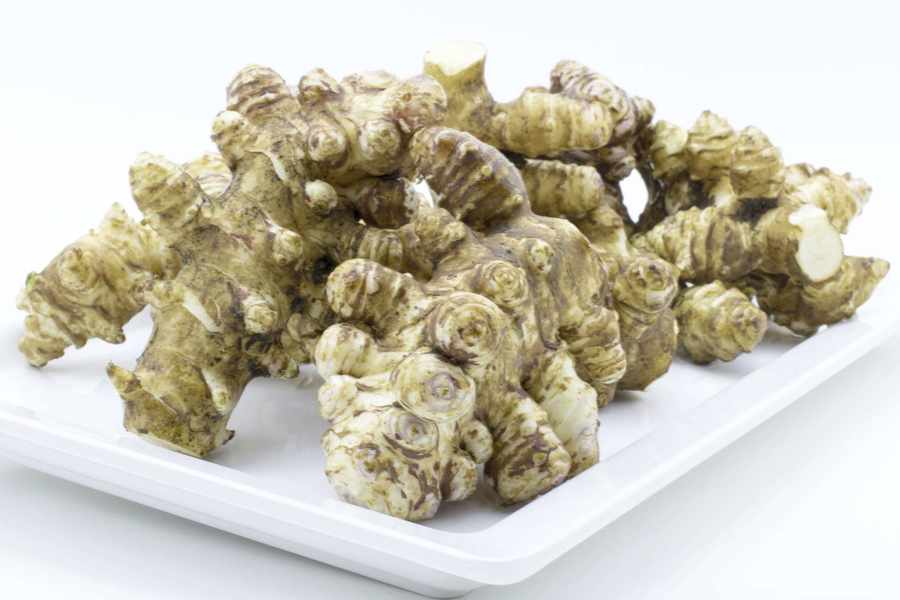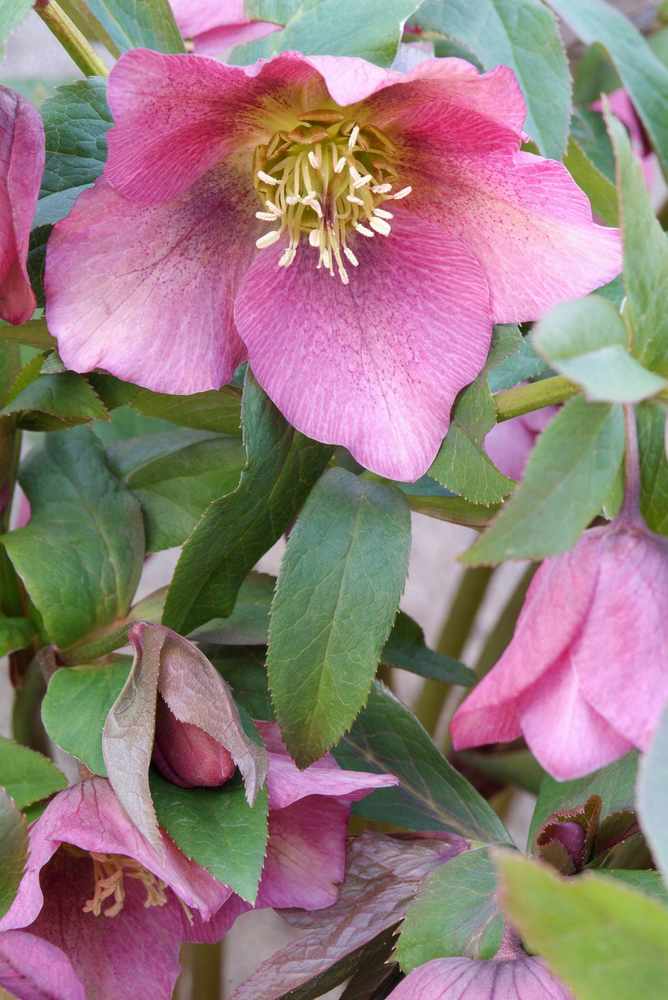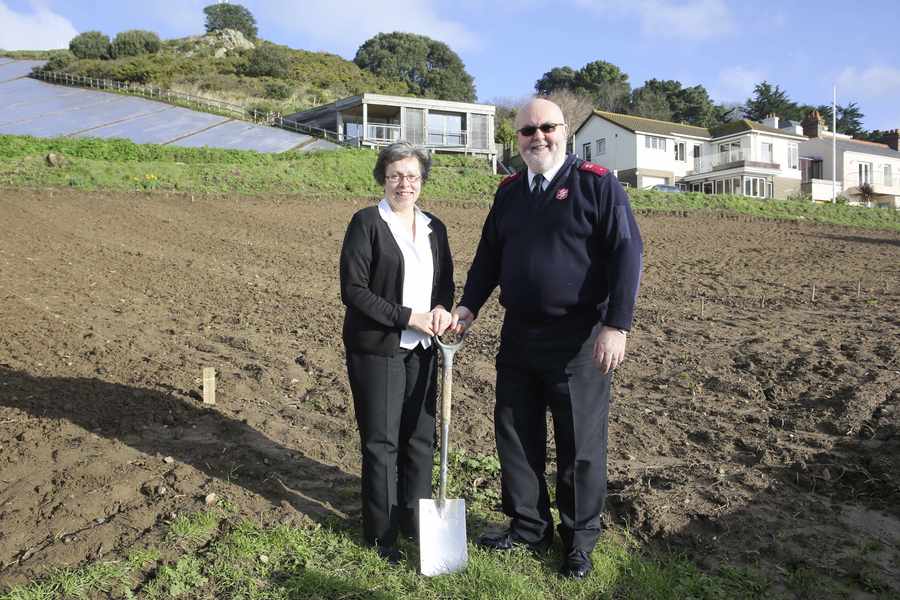The initiative, which is being spearheaded by church leaders Lieutenants Steve and Melanie Scoulding, will provide an opportunity for those who might not be able to access any other means of training.
- In the greenhouse, prick out seedlings and space them in bigger trays when they are big enough to transplant.
- Sow broad beans in pots under glass for planting out later.
- Place cloches over vegetable patches to warm the soil before planting.
- Plant new roses before spring.
- Plant new bare-rooted hedging plants from specialists for large areas.
- Continue planting new trees and shrubs.
- Dig up and store remaining parsnips in dry sand.
- Lift and divide established clumps of rhubarb which need rejuvenating.
- Prune summer-flowering shrubs.
- Keep topping up bird feeders and baths.
- Feed fruit trees with a fertiliser high in nitrogen.[/breakout]
Although it will only be possible to take on a small group, they will learn new skills, spending part of the week tending a large vegetable plot and part of the week learning about cooking and baking.
They will be involved through the whole food process, raising vegetables from seed, tending them while they are growing, harvesting them and then taking them into the kitchen, where the trainees will prepare and cook them for meals served to the community.
Steve Scoulding said that the scheme, which has the backing of the parish Constable and States Members, will help people back into the discipline of getting up and going to work.
It is also designed to boost their confidence. ‘It’s a major empowerment, being able to do things with your hands,’ he added. ‘It may be a small project, but it’s very exciting and it could make a big difference to people’s lives.’
To get the scheme off the ground, a community development officer will be appointed to act as a liaison between the Salvation Army and the various local agencies that will be involved.
The site that is being used for vegetable growing is about a third of an acre and adjoins Mr and Mrs Scoulding’s home in Gorey.
The property was derelict when they first moved to the Island three and a half years ago. It had been used as quarters for the officer who ran the Gorey corps, but it closed in 1966.
After that, it was rented out. ‘The Salvation Army was going to sell it, but we thought it would be a shame, especially having the field alongside, which could be used for mission work’ said Mr Scoulding.
‘We persuaded them to keep it, and last year the property was renovated.’
A great deal of work has also been undertaken on the vegetable plot, which was overgrown with weeds several feet high.
These have been cleared, the soil has been rotavated, dug and levelled and beds have been marked out ready for planting. A greenhouse is on order to raise seedlings, and membership of the National Vegetable Society is also on the cards, as advice has already been sought from the Jersey association’s chairman, Graeme Le Marquand.
Mr Scoulding said that the aim was to grow as organically as possible. Vraic would be put down at the end of the season, and waste would be composted.
A wide variety of produce will be cultivated, including Jersey Royal potatoes as the land favours early cropping, sloping southwards and making the most of the sunshine.
There will also be plants like sunflowers to encourage bees and other pollinating insects.
Most of the produce will make its way to the Salvation Army’s base in St Helier, where a new bakery and café are to be built in a downstairs part of the building.
Any surplus produce will be sold on a roadside stall, raising money for the charitable work undertaken for the community.
CAN it be normal for snapdragon and even cosmos to be in flower on the eve of 1 December? Normal or no, I found myself dead-heading a nodding pink specimen last weekend, enjoying the mild temperature and the odd speck of sunlight that drifted down over our muddy plots.
The nasturtiums were also paying attention and I wondered how confused our feathered friends must be, although grateful, I’m sure, for the abundance of worms and the relatively warm temperatures as we move into the ‘early winter’ season.
I certainly never expected the uncommonly warm days to continue beyond early November and so far, so good, for the tribes of plants currently populating my veggie plot. Several of the broad beans are now shooting up and would be tempted to come into flower, given half a chance.
The garlic sets I put in last month are now four to five inches above ground and seem to have survived without being spotted by sharp-eyed marauders from above.
Last week I popped in some late red and white onions – very late, I know, but it was not cold and nothing ventured, nothing gained – and some very slim shoots have begun to come up.
Fingers crossed for these, as although they are early varieties, they can also – apparently – be picked as spring onions, which would be rather nice, come the first months of next year.
Kale is looking good, although not much growth yet, and the cabbages are beginning to form their proper shape, now that the caterpillars have finally gone to ground. Spinach, too, is sprouting some nice young leaves – some have survived without the holes made by slugs – and they will make a timely addition to my salads, soups and other winter warmers.
I picked a couple of the early leeks at the weekend.
They’re a little small, compared to those in neighbouring plots, but will do fine in a casserole this week, and I’ll leave the rest in the ground to fatten up. However, the warmth has brought on the weeds, with a rash of that pesky chamomile-type daisy that seems to proliferate everywhere and has snuck in all over the path.
A little light weeding is needed, I think, well before midwinter’s night. And if the sky should blacken and the ground become hard and frosty, I will be digging deep into my freezer for the blackcurrants, strawberries and raspberries of summer days and brew up a tasty cocktail to pour over my favourite ice cream.
A NEW book entitled How To Make Your Own Cordials and Syrups, by Catherine Atkinson, shows how to make drinks from fruit, hedgerow harvests and home-grown herbs, season by season. The recipes range from child-friendly cordials made with natural ingredients to home-made alcoholic liqueurs and tipples to rival any shop-bought version at a fraction of the cost, helped by feeding your fruit trees with a fertiliser high in nitrogen. With this book, you can produce your own drinks all year round with recipes for every season, for example spring rhubarb and ginger syrup, red and blackcurrant cordial in the summer, hedgerow cordial in the autumn and mulled cranberry cordial to warm you up on winter days. You’ll also find recipes for classic liqueurs like sloe gin, limoncello and blackberry vodka. To win a copy of the book, simply answer the following question:
To get the a good yield out of your fruit trees, feed it with a fertiliser high in what?


Francis Le Quesne, proprietor of Le Quesne’s Garden Centre, answers your horticultural questions:
Q: I rather like the new varieties of Christmas roses, but they do seem rather expensive. Why is this, as I find them easy to grow?

Q: I was walking up Rozel Valley the other week and just above Château La Chaire there was a lovely smell wafting down the valley. It smelled like Daphne Odora (winter daphne), only more delicate. The party of people who were walking could all smell it. I couldn’t see any daphne about, so what do you think it might be?
A: I think what you were smelling was a lovely evergreen plant called Sarcococca Confusa, or Christmas box. This lovely small shrub produces masses of small white flowers that give off a pleasant and very strong fragrance. I know the area and a great band of this plant has been planted in a sloping garden in the valley. This wafts down beautifully as you walk by.
Q: I am trying to establish a fruit area in my small garden. I have seen apple trees growing against walls, taking up nearly no space at all. I would like to put one on my fence. What do I ask for?






